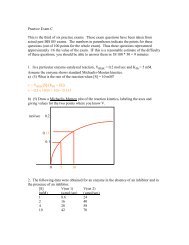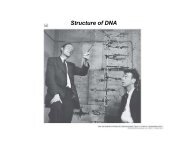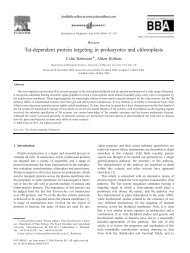The dual nature of homologous recombination in plants
The dual nature of homologous recombination in plants
The dual nature of homologous recombination in plants
- No tags were found...
You also want an ePaper? Increase the reach of your titles
YUMPU automatically turns print PDFs into web optimized ePapers that Google loves.
Review TRENDS <strong>in</strong> Genetics Vol.21 No.3 March 2005 179mutagenesis approach exhibited a 1000-fold <strong>in</strong>creasedfrequency <strong>of</strong> mitotic <strong>recomb<strong>in</strong>ation</strong> between <strong>homologous</strong>chromosomes, as measured by the endogenous ‘sulfur’system, while leav<strong>in</strong>g <strong>in</strong>trachromosomal HR unaffected.Unfortunately, the mutation could not be characterized [37].In the first reverse genetic approach mentioned above,that is, search<strong>in</strong>g for and characteriz<strong>in</strong>g publicly available<strong>in</strong>sertional mutants <strong>in</strong> specific genes, Arabidopsismutants <strong>in</strong> the genes RAD50, RAD9 and RAD17 couldbe obta<strong>in</strong>ed that exhibited <strong>in</strong>creased levels <strong>of</strong> HR, l<strong>in</strong>kedwith defects <strong>in</strong> DSB repair and hypersensitivity togenotoxic stress [38,39]. RAD9 and RAD17 were shownto be <strong>in</strong>volved <strong>in</strong> the cell-cycle checkpo<strong>in</strong>t <strong>in</strong> both yeastand Arabidopsis and might po<strong>in</strong>t to a connection betweenDNA damage signal<strong>in</strong>g and HR regulation (Figure 2). InArabidopsis both rad50 mutants, which are hypersensitiveto DNA damage and hyper-recomb<strong>in</strong>ogenic <strong>in</strong> somatictissue, and rad51 mutant <strong>plants</strong> [21] grow normally butare sterile. This is <strong>in</strong> sharp contrast to the situation <strong>in</strong>mouse where mutations <strong>in</strong> both genes abolish cell viability(as discussed <strong>in</strong> Refs [21,40]). Mammalian cells obviouslyrequire the activity <strong>of</strong> both genes for cell cycle progression.<strong>The</strong> <strong>in</strong>fluence <strong>of</strong> the rad50, rad9 and rad17 mutationson the level <strong>of</strong> HR seems to be <strong>in</strong>direct, which could po<strong>in</strong>tto a regulated balance between repair activities andaltered availability <strong>of</strong> damaged sites to repair mach<strong>in</strong>eries.A similar explanation could hold for <strong>plants</strong> mutated<strong>in</strong> the photolyase gene [41], impaired <strong>in</strong> scaveng<strong>in</strong>g <strong>of</strong>reactive oxygen species [42] and <strong>in</strong> <strong>plants</strong> upregulated forpathogen defense [43]: there, <strong>in</strong>creased HR could be due to<strong>in</strong>creased levels <strong>of</strong> DNA damage.<strong>The</strong> snm1 mutant was obta<strong>in</strong>ed by search<strong>in</strong>g for<strong>in</strong>sertional mutants <strong>in</strong> genes <strong>in</strong>ferred from functionalgenomic studies to be differentially regulated by genotoxicstress. It is defective <strong>in</strong> the <strong>in</strong>duction <strong>of</strong> somatic HR byspecific oxidative stress (Table 2) and could unravel theexistence <strong>in</strong> <strong>plants</strong> <strong>of</strong> a specific <strong>recomb<strong>in</strong>ation</strong>al repairpathway for oxidatively <strong>in</strong>duced DNA damage [44,45].<strong>The</strong> approaches to identify<strong>in</strong>g plant genes <strong>in</strong>volved <strong>in</strong>HR by knock<strong>in</strong>g out candidate genes will <strong>of</strong> course notyield new and unsuspected genes; only a screen directlytest<strong>in</strong>g for HR will permit this. In two different screensemploy<strong>in</strong>g the <strong>recomb<strong>in</strong>ation</strong> substrate l<strong>in</strong>es shown <strong>in</strong>Figure Ic and Id <strong>in</strong> Box 2, a multitude <strong>of</strong> mutants changed<strong>in</strong> HR levels were identified and isolated (O. Fritsch et al.,unpublished). Also, <strong>in</strong> one <strong>of</strong> these mutants the reason forthe strongly <strong>in</strong>duced frequency <strong>of</strong> HR seems to be <strong>in</strong>direct:a T-DNA-mediated knockout <strong>of</strong> the Centr<strong>in</strong>2 gene, encod<strong>in</strong>ga prote<strong>in</strong> <strong>in</strong>volved <strong>in</strong> recognition <strong>of</strong> DNA damage thatcan be repaired by the nucleotide excision repair (NER)pathway, led to a UV-C-sensitive, hyper-recomb<strong>in</strong>ogenicmutant. This po<strong>in</strong>ts to a novel connection between anearly step <strong>of</strong> NER and HR [46]. Another mutant, with areduced level <strong>of</strong> HR, was mutated <strong>in</strong> a gene cod<strong>in</strong>g forINO80, a member <strong>of</strong> the SWI–SNF ATPase family [47].<strong>The</strong> efficiency <strong>of</strong> NHEJ seemed unaffected <strong>in</strong> the mutant.In vitro <strong>in</strong>teraction <strong>of</strong> this prote<strong>in</strong> with nucleosomessuggested that INO80 acts through modification <strong>of</strong>chromat<strong>in</strong> structure, possibly at the site <strong>of</strong> DNA repair.Interest<strong>in</strong>gly, the yeast Ino80 prote<strong>in</strong>, as part <strong>of</strong> theINO80 complex, has recently been shown to be recruited towww.sciencedirect.comDSBs, <strong>in</strong> a manner dependent on phosphorylated histoneH2A [48]. Further studies are necessary to f<strong>in</strong>d out if theArabidopsis INO80 – or the potential complex thatconta<strong>in</strong>s it – is also recruited to sites <strong>of</strong> DNA damage,and if such recruitment leads to the specific engagement <strong>of</strong>the HR mach<strong>in</strong>ery.<strong>The</strong> <strong>in</strong>fluence <strong>of</strong> the environment on somatic HR<strong>The</strong> <strong>in</strong> planta assays described (Box 2) enable thequantitative assessment <strong>of</strong> HR events, thus permitt<strong>in</strong>gthe analysis <strong>of</strong> the <strong>in</strong>fluence <strong>of</strong> abiotic and biotic agents onHR. <strong>The</strong> effects <strong>of</strong> gamma radiation, UV radiation, heavymetals and pathogens on the physiological behavior <strong>of</strong><strong>plants</strong> have been amply described. However, the impact<strong>of</strong> these environmental factors on HR <strong>in</strong> genomes <strong>of</strong> theaffected <strong>plants</strong>, discussed <strong>in</strong> more general terms byMcCl<strong>in</strong>tock [49], has not been thoroughly studied untilrecently. Exposure <strong>of</strong> <strong>plants</strong> to gamma radiation – eitherresult<strong>in</strong>g from accidents <strong>in</strong> atomic power stations or <strong>in</strong> anexperimental setup – was expected to lead to higher levels<strong>of</strong> DSBs. Indeed, the use <strong>of</strong> <strong>plants</strong> carry<strong>in</strong>g <strong>recomb<strong>in</strong>ation</strong>reporter constructs yielded HR frequencies that directlyreflected the level <strong>of</strong> radioactive contam<strong>in</strong>ation [50].Especially <strong>in</strong>terest<strong>in</strong>g was the fact that even low levels<strong>of</strong> gamma radiation could be recorded with surpris<strong>in</strong>gaccuracy, open<strong>in</strong>g the possibility for environmental biomonitor<strong>in</strong>gregimes [51]. Other analyses <strong>of</strong> abiotic <strong>in</strong>fluenceson HR <strong>in</strong> Arabidopsis have <strong>in</strong>cluded tests with UV-B[52], heavy metals [53], X-rays, heat shock and UV-C(reviewed <strong>in</strong> Ref. [2]). <strong>The</strong> mechanisms by which themeasured <strong>in</strong>creases <strong>in</strong> rates <strong>of</strong> HR are established are notknown, but direct <strong>in</strong>duction <strong>of</strong> DSBs, the activity <strong>of</strong>reactive oxygen species and the upregulation <strong>of</strong> DNArepair activities are likely to contribute.<strong>The</strong> <strong>in</strong>fluence <strong>of</strong> biotic factors such as pathogens on<strong>plants</strong> has been studied from various aspects, but only afew studies focus on the possible effects <strong>of</strong> pathogens onthe genomes <strong>of</strong> <strong>plants</strong>. Elevated mutation rates <strong>in</strong> maizefollow<strong>in</strong>g virus <strong>in</strong>fection have been reported, but moleculardata are lack<strong>in</strong>g [54]. Inoculation <strong>of</strong> Arabidopsis l<strong>in</strong>esconta<strong>in</strong><strong>in</strong>g an HR reporter gene with Peronospora parasiticaled to stimulation <strong>of</strong> somatic HR. <strong>The</strong> same effectwas observed when pathogen defense mechanisms werechemically or genetically activated <strong>in</strong> the absence <strong>of</strong> apathogen [43]. Infection <strong>of</strong> tobacco <strong>plants</strong> carry<strong>in</strong>g<strong>recomb<strong>in</strong>ation</strong> markers with tobacco mosaic virus (TMV)yielded <strong>in</strong>creased <strong>recomb<strong>in</strong>ation</strong> rates not only <strong>in</strong> <strong>in</strong>oculatedleaves but also <strong>in</strong> non<strong>in</strong>oculated leaves [55].Treatment <strong>of</strong> <strong>plants</strong> with UV-B or with TMV led to an<strong>in</strong>creased rate <strong>of</strong> HR-mediated genetically fixed restoration<strong>of</strong> the functional reporter gene (Box 2) <strong>in</strong> the<strong>of</strong>fspr<strong>in</strong>g [52,55]: the number <strong>of</strong> seedl<strong>in</strong>gs that werecompletely b-glucuronidase- or luciferase-positive wasgreater <strong>in</strong> the <strong>of</strong>fspr<strong>in</strong>g <strong>of</strong> treated <strong>plants</strong> than <strong>in</strong> those <strong>of</strong>untreated <strong>plants</strong>. It is unclear, however, whether these<strong>in</strong>duced events were due to somatic HR events late <strong>in</strong>plant development, that is, before or after meiosis, or dueto enhanced rates <strong>of</strong> mHR.An <strong>in</strong>crease <strong>in</strong> either somatic or meiotic HR couldfacilitate evolutionary adaptation <strong>of</strong> plant populationsto stressful environments. Possible substrates for








